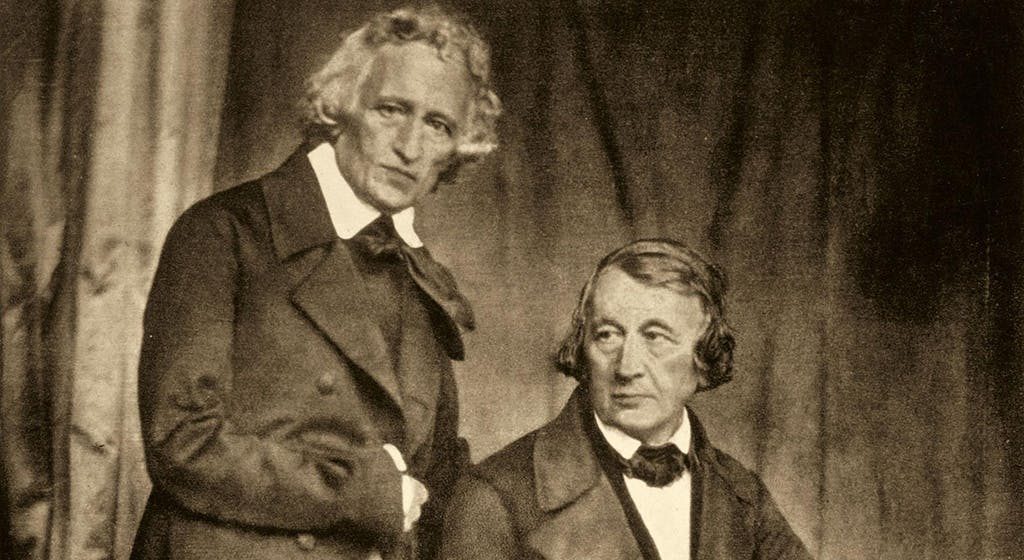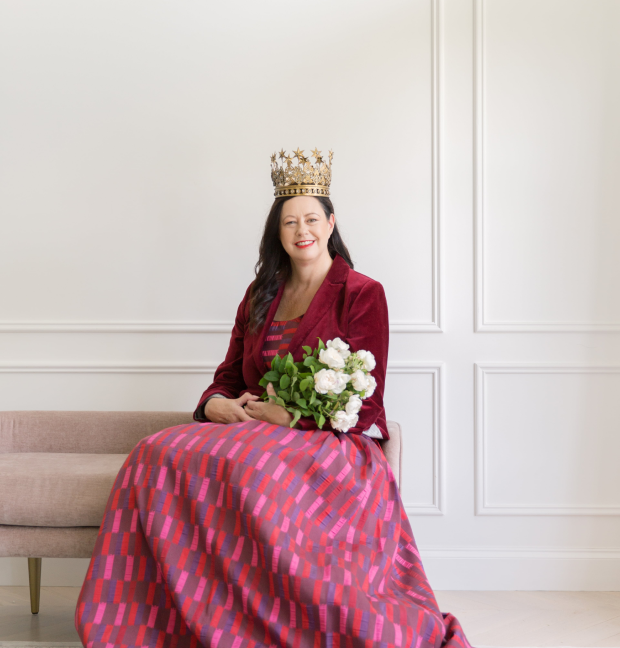
Once upon a time there were two brothers who lived in a small kingdom in the middle of a crazy patchwork of other small kingdoms, each with its own prince or archduke to rule it. Some of these kingdoms were so small the princes could fire at each other from their castle walls.
The two brothers – named Jakob and Wilhelm Grimm – were the eldest of a family of six, all boys except for the youngest who was a girl named Lotte.
Next door to the Grimm family lived a family of six girls and one boy named the Wilds. They lived side-by-side on the Marktgasse in the medieval quarter of a town named Cassel, famous for its palace set in vast gardens and forests.
Jakob and Wilhelm and their family were desperately poor. Their father had died, and the two elder brothers struggled to feed and clothe their siblings.
One day a mighty emperor called Napoleon decided he wished to rule the world. On his way to seize the thrones of the other great kings and emperors of the world, he took over the Grimm brothers’ small kingdom and mashed it together with many of its neighbours to create the Kingdom of Westphalia. He set his young brother Jérôme up as king. In his first week, Jérôme played leapfrog in his underwear with his courtiers through the empty halls of the palace, then spent a fortune ordering new furniture from Paris.
Life was very hard for the Grimms. Everything changed under French occupation – the laws of the land, the weights and measurements, even the language everyone must speak - and censors meant the newspapers only printed what Napoleon wanted people to know.
Partly as an act of defiance, and partly in the hope of making some money, the Grimms began to collect old stories from their neighbours and friends, with the aim of publishing a scholarly book.
The Wild girls who lived next door knew many stories, particularly Lotte’s best friend, the fifth daughter, who was named Dortchen. She told Wilhelm many tales, including ‘The Frog King’, ‘Hansel and Gretel’, ‘Six Swans’ and ‘Rumpelstiltskin’.
Wilhelm and Dortchen fell in love, but the Grimms were so poverty-stricken they could only afford one meal a day. Wilhelm’s and Dortchen’s only chance to marry was if the fairy tale collection was a success.
Unfortunately, the book was a failure. It was criticised for being too scholarly, too unsophisticated, and filled with too much sex (some of the stories were indeed ripe with sexual innuendo).
It was a time of war and terror and tyranny. Napoleon marched on Russia. The fields of Europe were burned black, and many hundreds of thousands of people died.
Wilhelm struggled on (his elder brother Jakob was now busy with other scholarly undertakings). He collected more tales, from Dortchen as well as from other storytellers, and he rewrote the stories to make them more palatable to a middle-class audience. He added such terms as ‘once upon a time’ and ‘happily ever after’, and made sure the princess did not take the frog into her bed anymore.
Slowly the war was won, and peace returned. Slowly the fairy tales began to sell. Slowly the Grimm brothers’ reputation grew. At last, thirteen years after they first fell in love, Wilhelm and Dortchen were able to marry. They lived together with Jakob happily until their deaths.
Dortchen’s Tales:
One young woman named Dortchen Wild told the Grimm brothers almost one-quarter of all the tales in their first collection of fairy stories, when she was just nineteen years old. Stories she told include:
‘Rumpelstiltskin’
‘Hansel and Gretel’
‘The Frog-King’
‘Six Swans’
‘The Elves and the Shoemaker’
‘The Singing Bone’
‘Sweet Porridge’
‘Mother Hulda’
‘Three Little Men in the Wood (a version of ‘Diamonds & Toads’)
‘Sweetheart Roland’ (about a girl whose betrothed forgets her)
‘Fitcher’s Bird’ (A Bluebeard variant where the heroine saves herself and her sisters)
‘The Singing, Springing Lark’ (a very beautiful version of ‘Beauty and the Beast’)
‘All-Kinds-of-Fur’ (an incest tale)
Dortchen also contributed many folk sayings and proverbs to the tales, and made up some of the rhymes, including the famous verses in ‘Hansel and Gretel’.
Seven Fascinating Facts about the Grimms & their Fairy Tales
Just how grim are the Grimm tales?
* In the 1812 version of the Grimm’s tale ‘Little Snow-White’, it is the heroine’s own jealous mother that wants her dead. She tells the huntsman to bring back her daughter’s lungs and liver, for her to eat. Wilhelm Grimm later changed the mother to a step-mother.
* The jealous queen was punished by Little Snow-White and her prince by being forced to dance in red-hot iron shoes till she died.
* In the original (1812) version of ‘The Frog King’, the princess does not kiss the frog to change him into a prince. Instead, she throws him as hard as she can against a wall.
* In ‘Aschenputtel’, the Grimm’s version of ‘Cinderella’, one wicked stepsister cuts off her toes to try and make the slipper fit and the other cuts off her heel. In the end, they have their eyes pecked out by pigeons.
* In a later edition (1857) of ‘Rumpelstiltskin’, the dwarf tears himself in two when the queen guesses his true name. This detail was added in by Wilhelm, quite possibly because he thought it was funny
* in one Grimm tale, ‘The Maiden Without Hands,’ a girl’s hands are chopped off by her own father
* The villain of ‘Fitcher’s Bird’ is a sorcerer that travels about the countryside, kidnapping girls and hacking them to pieces in a hidden room.
* In ‘All-Kinds-of-Fur’, a girl disguises herself in a coat made from the fur flayed from a thousand animals
* in many cases, Wilhelm made the stories more violent – particularly the punishments for witches and evil step-mothers
* nonetheless, nearly all of the tales end happily, with the hero or heroine triumphing because of their courage, goodness, and wit
Ten Things you didn’t know about Napoleon

